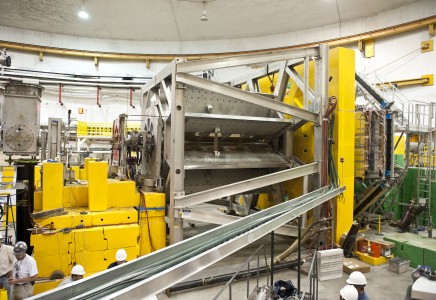The Weak Side of the Proton

Image courtesy of DOE’s Jefferson Lab - The Q-weak experiment was conducted in Jefferson Lab's Experimental Hall C, and its goal was to very precisely measure the proton's weak charge, a term that quantifies the influence that the weak force can exert on protons. The Q-weak apparatus, shown here, was installed in the hall for the experimental run, which concluded in 2012.
Additional Links
A precision measurement of the proton’s weak charge narrows the search for new physics.
The Science
The weak force is one of the four fundamental forces in our universe, along with gravity, electromagnetism and the strong force. Researchers have made the first experimental determination of the weak charge of the proton, a measure of the precise strength of the weak force’s influence on the proton.
The Impact
The determination of the proton’s weak charge provides a precision test of the weak force, and it also constrains possibilities for new particles and forces beyond our present knowledge.
Summary
The weak force is one of the four fundamental forces in our universe, along with gravity, electromagnetism and the strong force. Its effects can be observed in our everyday world: It initiates the chain of reactions that power the sun, and it provides a mechanism for radioactive decays that partially heat the Earth’s core and that also enable doctors to detect disease inside the body without surgery. It is known that the weak force acts directly on subatomic particles, such as the protons, neutrons and electrons that make up atoms. These particles carry a weak charge, a measure of the influence that the weak force can exert on them. To measure the weak charge of the proton, an intense beam of electrons generated by Jefferson Lab’s Continuous Electron Beam Accelerator Facility was directed onto a target containing cold liquid hydrogen. The electrons that scattered from the protons inside the target were detected in a precise, custom-built apparatus. The electrons in the beam were highly polarized – a mechanical analogy would be that the electrons were mostly “spinning” in one direction, parallel or anti-parallel to the beam direction. By precisely and rapidly reversing the direction of polarization, the experimenters were able to latch onto the weak force’s unique property of parity violation to isolate its tiny effects. The proton’s weak charge was found to be QWp=0.0719±0.0045. The new result is in excellent agreement with the predictions of the Standard Model, and so it serves as a test of the model and can impact its predictions. For example, it has set limits on the possible existence of leptoquarks, which are hypothetical particles that can reverse the identities of two broad classes of very different fundamental particles – turning quarks (the building blocks of nuclear matter) into leptons (electrons and their heavier counterparts) and vice versa. Numerous technical achievements made this experiment possible. These include the high-current, high-polarization, extremely stable electron beam provided by the Continuous Electron Beam Accelerator Facility; the world's highest-power cryogenic hydrogen target; extremely radiation-hard Cerenkov detectors; ultra-low noise electronics for signal readout and beam current measurement; and a system that measures the beam polarization to better than 1 percent.
Contact
Roger Carlini
Jefferson Lab
carlini@jlab.org
Funding
This work was supported by the U.S. Department of Energy Office of Science, the National Science Foundation, the Natural Sciences and Engineering Research Council of Canada, and the Canadian Foundation for Innovation, with matching and in-kind contributions from a number of the collaborating institutions.
Publications
The Jefferson Lab Qweak Collaboration. “Precision measurement of the weak charge of the proton.” Nature 557, 207-211 (2018). doi: 10.1038/s41586-018-0096-0
Related Links
Proton's Weak Charge Determined for First Time
Q-weak Backgrounder: Probing the Proton's Weak Side
Getting a Better Measure of Spin with Diamond
May 2018

